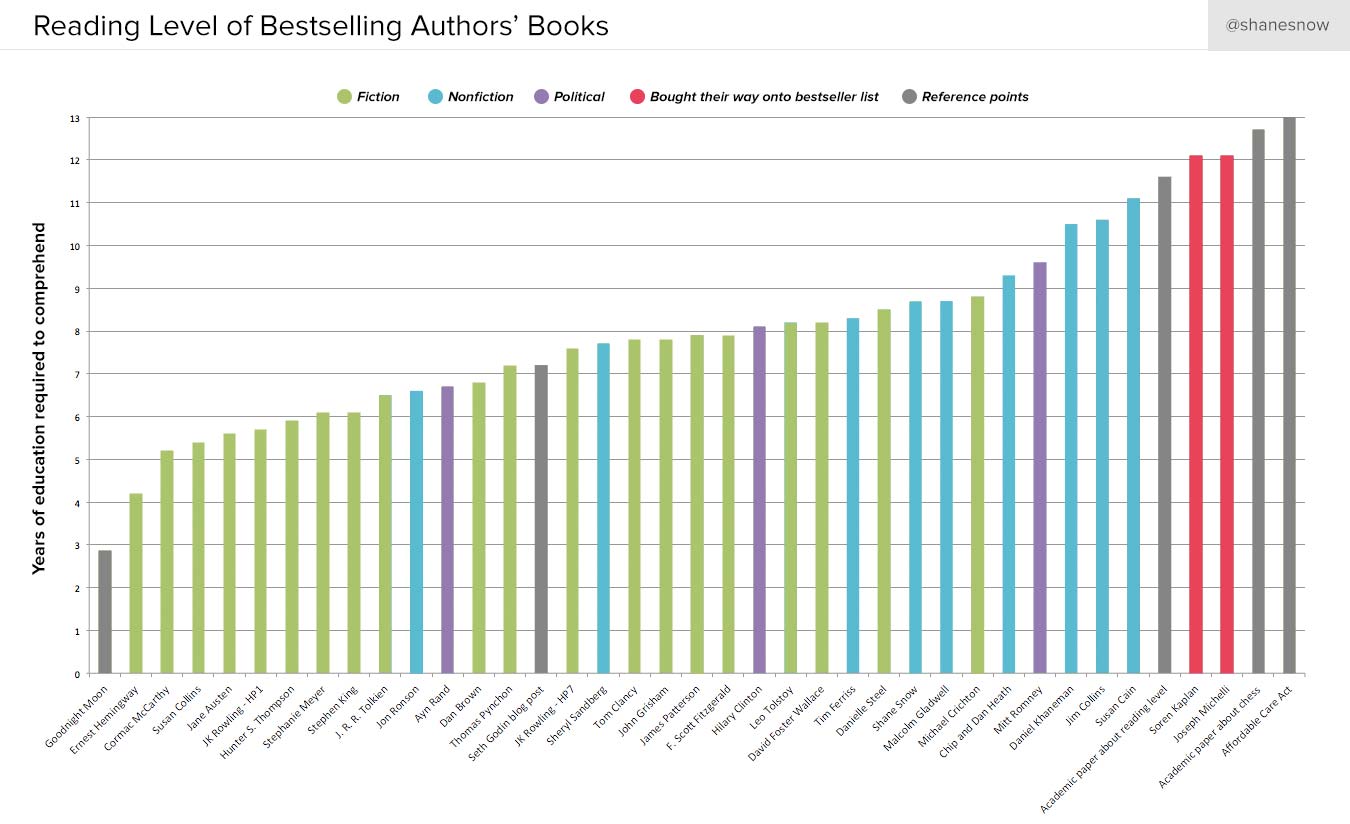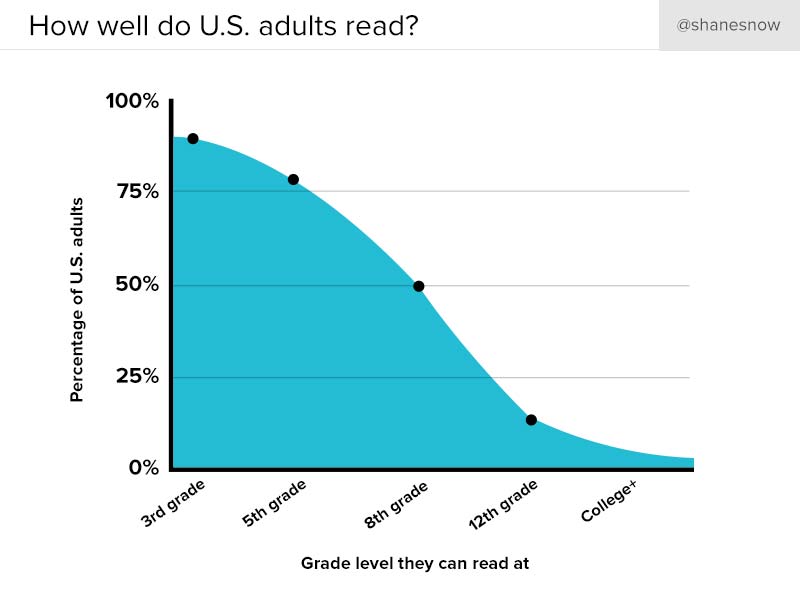The other day, I wrote a post with some advice for new writers. Something I highlighted in that blog was the need to adapt your writing for your audience, especially while working in content marketing. It’s easy to come out of university with a specifically academic tone of voice.
I noted that the average person reads below a college level and that recreationally we all prefer to read a few grade levels below what we’re capable of. A few of you reached out to me in shock! We’re conditioned in schools to believe that more complex writing is inherently better.
Unfortunately, while your flowery sentence structure might look impressive, it doesn’t make your content easily consumable.
Shane Snow recently decided to run all of his favourite writers through a test to determine the grade level of their writing.

“The initial surprise from my little data experiment is that writers whose work we regard highly tend to produce work at a lower reading level than we’d intuit. Cormac McCarthy, Jane Austen, and Hunter S. Thompson join J.K. Rowling in the readability realm of pre-teens. The content of McCarthy’s and Thompson’s novels isn’t meant for children, but these writers’ comprehensibility is rather universal.”1
Hemingway clocks in at needing only four years of education! And if it’s good enough for The Old Man and the Sea, I suspect it’s good enough for most of us.
What makes great writing isn’t complex sentence structure, it’s compelling and shareable stories. In most cases, complex writing detracts from engaging content. If your readers are focusing on digesting and understanding the material, they may be missing out of the message and emotion in your stories.
So how well do Canadians and Americans actually read?
Literacy proficiency is measured on a scale from 1-500, and then grouped into five levels:2
- Level 1: You have difficulty decoding any printed materials, and are likely to self-identify as illiterate.
- Level 2: You use printed materials in a limited way, and can identify familiar words.
- Level 3: You can read many materials, as long as they’re not too complex. You might not identify as having major difficulties, but you tend to avoid situations requiring reading.
- Level 4 and 5: You have strong literacy skills, and can deal with complex material.
In 2012, 51.5% of Canadians between 16-65 had literacy scores at Level 3 or higher. Shockingly, 37.6% of our population were at a Level 3, which means that only 13.9% of Canadians are reading at a Level 4 or 5. And, a full 27% of people who reported that they have a bachelor’s degree or higher had a literacy level of 1 or 2.3
This has huge implications! Higher education doesn’t guarantee an excellent level of literacy, and only 14% of Canadians have strong literacy skills.
Americans have very similar stats:4

It turns out that only 50% of Americans read at a Grade 8 reading level.
Now, if that wasn’t jaw-dropping enough for you, here’s the kicker! Research shows that when reading recreationally, people actually prefer to read two grade levels below what they’re actually capable of.5 This makes sense to me. If you’re using all your mental energy on decoding the writing, you definitely aren’t enjoying yourself or appreciating the story.
So, what can you do to make sure you’re getting your point across?
- Don’t just think about how you like to write. Prioritize how your audience likes to consume their content.
- Focus on your message, not your sentence structure. Remember, just because your content is written in plain language, doesn’t mean it will be shareable. Your message still has to be compelling!
- Use scannability techniques to make your content consumable. Good structure including lists and subheaders make it easy for people to digest the information you’re presenting.
- Decide on a reading level range that’s appropriate for your brand. Unless you’re an academic institution, staying under Grade 9 is safe. Consider the needs of your specific audience.
- Use a grader like Flesh-Kincaid or Wriber’s built-in grade level checker to confirm the grade level of your content.
Additional thoughts:
- Wriber tells me that this post was written at a Grade 7 reading level.
- In 2012, Canadians between 25-34 had the highest average literacy skills.6 I can’t find more updated data. If anyone can tell me if this is generational, or typical for that age group, I’m so curious! Now, 4 years later, is it those 29-38 who have the highest average literacy skills, or is it still Canadians between 25-34?
Sources:
- This Surprising Reading Level Analysis Will Change the Way You Write
- Government of Canada, Definition of Adult Literacy
- Government of Canada, Adult Literacy
- This Surprising Reading Level Analysis Will Change the Way You Write
- Klare, G.R. and B.Buck.1954. Know Your Reader: The scientific approach to readability. New York: Heritage House.
- Government of Canada, Adult Literacy
John is the Founder & CEO of Wriber. He’s passionate about entrepreneurship, high-tech startups, thought leadership, content marketing, and artificial intelligence. John frequently volunteers his time at the University of Waterloo to help young entrepreneurs get their businesses off the ground. He’s also a faithful Toronto Maple Leafs fan, frequent Redditor, and lifelong learner.

